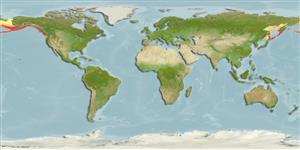Classification / Names
Common names from other countries
Main reference
आकार / वज़न / Age
Max length : 84.0 cm TL पुल्लिंग / अलिंग; (Ref. 5723); 71.0 cm (female); common length : 45.0 cm TL पुल्लिंग / अलिंग; (Ref. 9988); common length :58 cm (female); अधिकतम प्रकाशित वज़न: 7.7 kg (Ref. 40637); अधिकतम सूचित उम्र: 8 वर्षो (Ref. 72462)
Length at first maturity
Lm 60.0 range ? - ? cm
पर्यावरण
; समुद्री; स्वच्छ जल, अलवण जल; खारा; ऐनाढरोमस (Ref. 51243); गहराई सीमा 0 - 250 m (Ref. 50550)
जलवायु / सीमा
Temperate; ? - 25°C (Ref. 35682), preferred 3°C (Ref. 107945); 72°N - 42°N, 130°E - 109°W (Ref. 54685)
वितरण
North Pacific: northern Japan to Bering Sea and to Los Angeles, California, USA (Ref. 2850). Landlocked populations in Alaska, Yukon Territory and British Columbia in Canada, and Washington and Oregon in USA.
देश | ऐफ ऐ ओ क्षेत्र | Ecosystems | संयोग | भूमिका
Short description
पृष्ठीय रीढ़ (सम्पूर्ण): 0; पृष्ठीय सौफट रेज़ (सम्पूर्ण): 11-16; गुदा कांटा 0; ऐनल सौफट रेज़: 13 - 18; जानवरों की रीड़ का जोड़: 56 - 67. Both the sockeye and the kokanee are distinguished by the long, fine, serrated, closely spaced gill rakers on the first arch that number between 30 and 40, and by its lack of definite spot on the back and tail (Ref. 27547). Body fusiform, streamlined, laterally compressed, body depth moderate, slightly deeper in breeding males (Ref. 6885). Head bluntly pointed, conical, eye rather small, position variable with sex and condition; snout rather pointed (Ref. 6885). Lateral line straight (Ref. 27547). Pelvic fins with axillary process; caudal emarginate (Ref. 27547). Pre-spawning fish are dark steel blue to greenish blue on the head and back, silvery on the sides and white to silvery on the belly; no definite spots on the back, although some individuals may have dark speckling and irregular marks on the dorsal fin (Ref. 27547). At spawning, the head of the males becomes bright to olive green, with black on the snout and upper jaw; the adipose and anal fins turn red and the paired fins and tail generally become grayish to green or dark; females are generally less brilliantly colored than males (Ref. 27547). Various populations may show less brilliant colors, and a few turn dull green to yellowish, with little if any red (Ref. 27547).
IUCN Red List Status (Ref. 115185)
Threat to humans
Harmless
Human uses
मात्स्यिकी: उच्च वाणिज्य; जलीयकृषि: व्यापारिक; आखेट मत्स्य: हां; जलजीवालय: सार्वजनिक लजीवालय
साधन
Special reports
Download XML
इंटरनेट स्रोत
Estimates of some properties based on models
Phylogenetic diversity index
PD50 = 0.5000 many relatives (e.g. carps) 0.5 - 2.0 few relatives (e.g. lungfishes)
Trophic Level
3.5 ±0.2 se; Based on diet studies.
लौटाव
माध्यम, न्यूनतम जनसंख्या दुगनी होने का समय 1.4 - 4.4 वर्ष। (K=0.37-0.58; tm=2-4; tmax=7; Fec=300)
Vulnerability
Low to moderate vulnerability (32 of 100)
Price category
